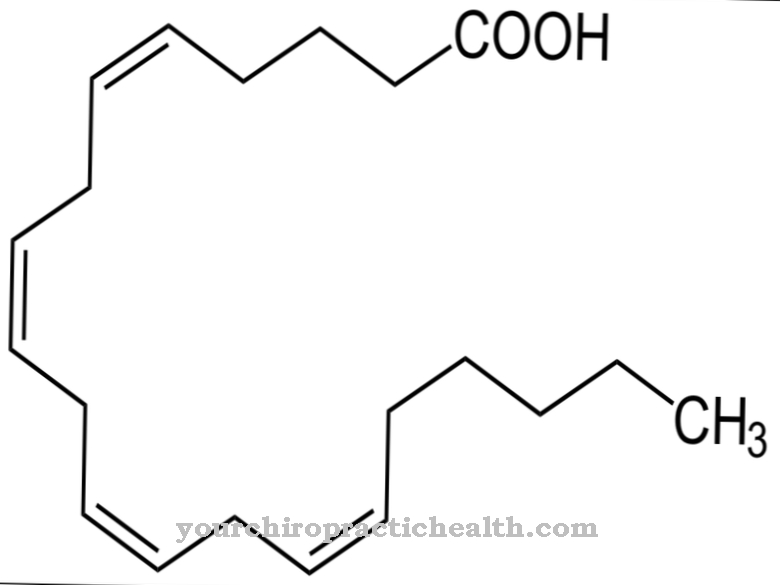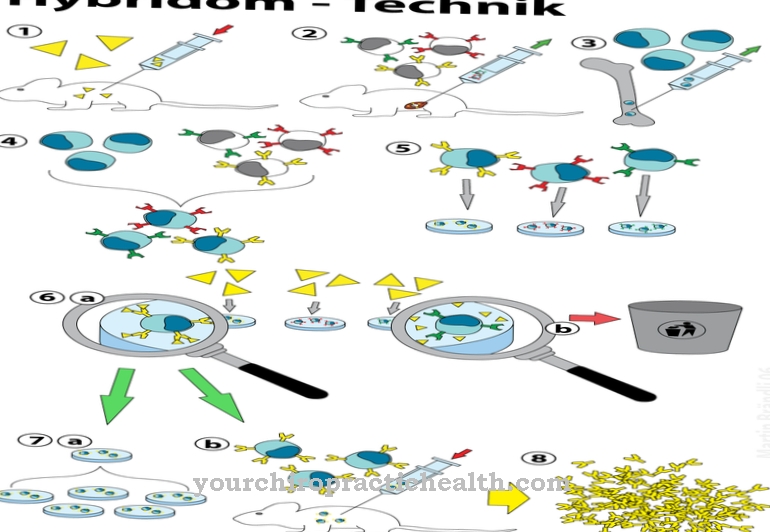The Arachidonic acid belongs to the polyunsaturated fatty acids. It is semi-essential for the body. Arachidonic acid is mainly found in animal fats.
What is arachidonic acid?
Arachidonic acid is a four-fold unsaturated fatty acid and belongs to the omega-6 fatty acids. Omega-6 fatty acids serve as a precursor to prostaglandins and thus play an important role in inflammatory processes.
Most of the arachidonic acid requirement is met through food. The fatty acid is mainly found in products of animal origin. Arachidonic acid can also be synthesized from another omega-6 fatty acid. Anti-inflammatory drugs often target the metabolism of arachidonic acid.
Function, effect & tasks
Omega-6 fatty acids and therefore also arachidonic acid are vital for the body. They serve as building blocks for various substances in the body. Other fatty acids are also built from omega-6 fatty acids.
The unsaturated fatty acids also take on important functions in the construction of cell membranes. They are responsible for the flexibility of the cell walls. Fatty acids also play an important role in skin metabolism. They can counteract skin irritation and the formation of eczema. Arachidonic acid is also said to reduce the size of blackheads. The fatty acid also serves to transport oxygen through the lungs.
Arachidonic acid is also important for nerve and brain cells. It maintains the healthy structure of the cell membranes and thus also protects against neurological diseases. Arachidonic acid also plays an important role in immune defense and wound healing.
The body also produces the so-called eicosanoids from arachidonic acid. Eicosanoids are messenger and signaling substances that influence many processes in the body. These include, for example, hormonal and inflammatory processes. Depending on the dosage, arachidonic acid can promote or alleviate inflammation. The condition of the individual also seems to have a decisive impact on the metabolism of arachidonic acid.
Education, occurrence, properties & optimal values
Arachidonic acid can only be partially produced by the body itself. The majority of arachidonic acid comes from food. If the body has sufficient amounts of linoleic acid, it can also convert it to arachidonic acid. Arachidonic acid is mainly found in foods of animal origin.
Chicken, pork liver, veal, labskaus, omelette, milk, eel and croissants are rich in arachidonic acid. The German Nutrition Society (DGE) recommends a ratio of 1: 5 for the intake of omega-3 and omega-6 fatty acids. This means that humans should consume five times more omega-6 than omega-3 fatty acids. The reality is currently different. Due to today's eating habits, the ratio is usually 1:10. In this unhealthy ratio, arachidonic acid often shows its inflammatory properties.
Diseases & Disorders
People who suffer from rheumatic diseases should avoid foods with a high arachidonic acid content. An example of such a disease is rheumatoid arthritis.
In rheumatoid arthritis, the joints are affected by persistent inflammation. These inflammations are caused and maintained by inflammation mediators. The inflammation mediators are also known as eicosanoids. These include, for example, prostaglandins, leukotrienes or thromboxanes. The body itself produces all of these inflammation mediators from arachidonic acid.
Such strong and, above all, permanent inflammatory processes would hardly be possible without arachidonic acid. A reduced supply of arachidonic acid can therefore have a positive effect on the course of rheumatic diseases. Eicosapentaenoic acid, which is also known as EPA for short, also has a positive effect. Its chemical structure is similar to arachidonic acid and therefore also binds to the same cell receptors as arachidonic acid. In contrast to the inflammation-promoting fatty acid, EPA does not trigger the formation of inflammatory mediators.
Arachidonic acid and EPA compete for the same enzymes, so EPA can have an anti-inflammatory effect in this way. One speaks here of a competitive inhibition. EPA is one of the omega-3 fatty acids and is mainly found in vegetable oils such as rapeseed oil, soybean oil, linseed oil or safflower oil.
A diet low in arachidonic acid is also recommended for patients with multiple sclerosis. Multiple sclerosis is a chronic inflammatory disease of the nervous system. Here the myelin sheaths of the nerve cells become inflamed, so that the transmission of stimuli is disturbed. Numerous symptoms such as paralysis, weakness, depression, incontinence, speech disorders or visual disturbances can be the result. The arachidonic acid can fuel these inflammatory processes and thus lead to an exacerbation of the symptoms.
Of course, diseases can also arise from a lack of arachidonic acid. A lack of fats can arise in different ways. A very one-sided diet or a long fat-free diet can result in a fat deficiency. But diseases of the gastrointestinal tract can also lead to a deficiency. An example of such a disease is pancreatic insufficiency. Here the pancreas no longer produces enough digestive enzymes. Fat-splitting enzymes are also no longer available in sufficient quantities. As a result, the ingested dietary fats cannot be used properly and are partially excreted again undigested. This can also be seen in the patient's bowel movements. The stool is often shiny, greasy, and very bulky. One speaks here of a fatty stool.
A lack of fats can lead to a lack of energy. The metabolism goes down and those affected lose a lot of body weight. With a deficiency in omega-6 fatty acids, patients suffer from impaired vision, muscle weakness and poor cognitive performance. Skin diseases, impaired wound healing, increased susceptibility to infection, anemia and breathing difficulties can also be the result of an insufficient supply of omega-6 fatty acids, such as arachidonic acid.



























